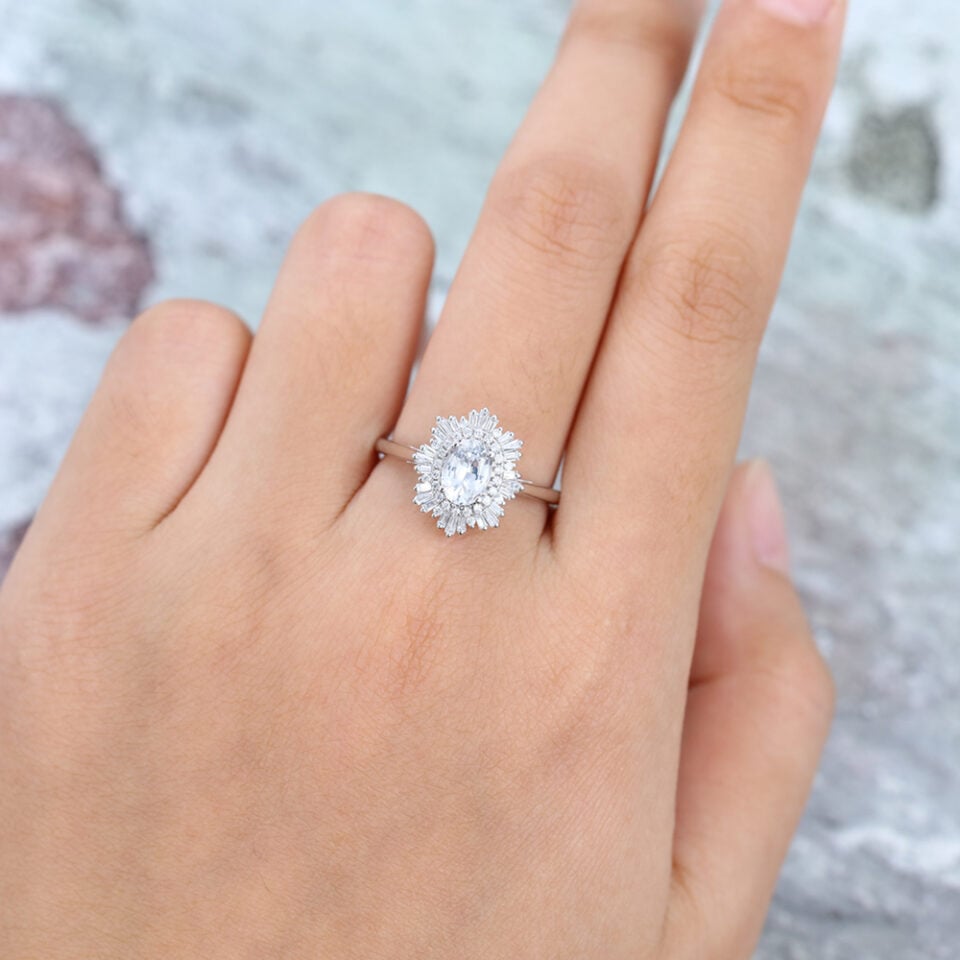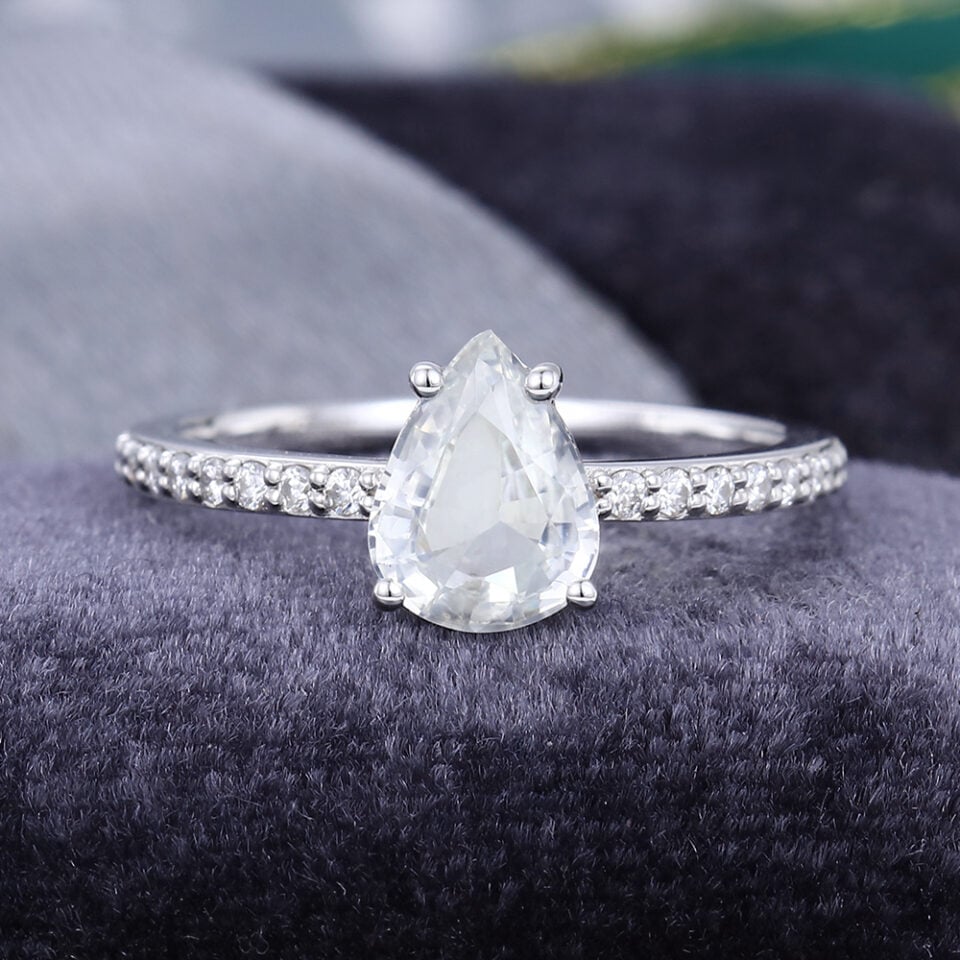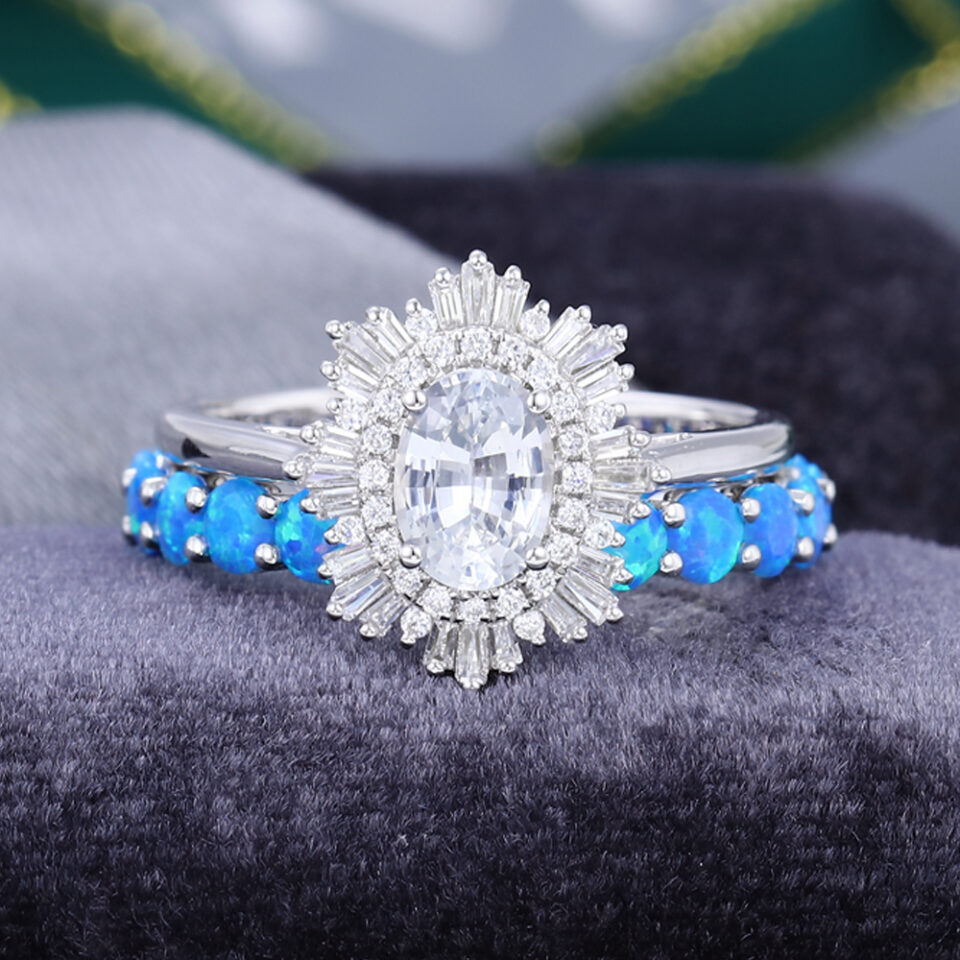CoolringJewelry presents a stunning collection of White Sapphire Rings, redefining elegance and sophistication in the world of fine jewelry. Our exquisite selection showcases the timeless allure of white sapphires, offering a brilliant and ethical alternative to traditional diamond rings. Whether you’re seeking the perfect engagement ring, a symbol of love and commitment, or a dazzling accessory for any occasion, our White Sapphire Rings combine exceptional craftsmanship with the unmatched brilliance of colorless sapphires. Discover the radiance, durability, and affordability of these gemstones, thoughtfully designed in a range of styles to suit your individual taste. CoolringJewelry invites you to explore a world of pure, sparkling beauty with our White Sapphire Rings.
White Sapphire Rings
Showing all 6 results
White sapphire rings are jewelry pieces featuring white sapphires as the central gemstone. These rings are popular for their elegant and timeless appearance, resembling diamond engagement rings. White sapphires are colorless, transparent gemstones that exhibit brilliance and durability, making them a compelling alternative to traditional diamond rings. They are often used as center stones in various ring designs, including solitaire, halo, three-stone, and more. White sapphire rings are not only prized for their beauty but also for their affordability compared to diamond counterparts. They are an excellent choice for engagement rings, anniversary bands, or everyday fashion jewelry, offering a touch of sophistication and sparkle.
Gemstone rings come in a wide variety of options, each with its unique beauty and properties. Common types of gemstones used in gemstone rings include:
- Diamond:
Renowned for its brilliance and durability, diamonds are a classic choice for engagement and wedding rings.
Available in various colors, blue sapphires are especially popular, but sapphires also come in shades like pink, yellow, and green.
Known for its deep red color, rubies are both vibrant and symbolize love and passion.
- Emerald:
With its rich green hue, emeralds are a symbol of rebirth and love, often used in elegant rings.
This purple variety of quartz is known for its calming and spiritual qualities.
- Aquamarine:
With its light blue color, aquamarine symbolizes tranquility and is often used in vintage-style rings.
Opals are prized for their unique play of colors, making each opal ring one of a kind.
This pale pink to peach-pink gemstone is becoming more popular in engagement rings.
This unique gemstone can change color from green in daylight to red under incandescent light.
A striking blue or greenish-blue stone often used in bohemian or southwestern-style rings.
Known for its adularescence, moonstone has a mystical, almost ethereal quality.
Agate is a variety of chalcedony with distinctive banding patterns and comes in a wide range of colors, making it a popular choice for both its aesthetic appeal and its metaphysical properties.
These are just a few of the many gemstone options available for rings. The choice of gemstone often depends on personal preferences, style, and the significance or symbolism associated with the stone.
White Sapphire Rings FAQ:
A white sapphire is a colorless variety of the mineral corundum, which is primarily composed of aluminum oxide (Al2O3). Sapphire is most commonly associated with its blue variety, but it comes in a range of colors, and when it lacks any significant color, it is referred to as “white sapphire.” White sapphires are valued for their brilliance, hardness, and durability, making them a popular choice for gemstone jewelry, especially in engagement rings.
The lack of color in white sapphires sets them apart from colored sapphires, such as blue, pink, yellow, and other fancy colors, which get their hues from the presence of trace elements in the crystal lattice. White sapphires have a clear, transparent appearance, and they can exhibit a high level of brilliance and sparkle, similar to diamonds. However, they do not possess the same level of fire (the dispersion of light into its spectral colors) as diamonds.
White sapphires are often used as diamond alternatives in jewelry due to their attractive appearance and hardness, which makes them resistant to scratching. While they are less expensive than diamonds, they can still be quite valuable and are considered a more affordable and ethical choice for those who prefer a colorless gemstone.
White sapphires are valuable gemstones, although their value is generally lower than that of other colorless gemstones like diamonds. Several factors contribute to the value of white sapphires:
Brilliance: White sapphires are renowned for their exceptional brilliance, which results from their high refractive index. This quality makes them attractive as gemstones for jewelry.
Hardness: Sapphires, including white sapphires, are among the hardest gemstones, ranking just below diamonds on the Mohs scale. This hardness ensures their durability and resistance to scratches, enhancing their long-term value.
Rarity: While not as rare as certain colored sapphires, truly colorless white sapphires are relatively rare, especially in larger sizes.
Ethical Considerations: White sapphires are often considered a more ethical and environmentally friendly choice compared to diamonds due to their lower environmental and social impact in the mining process.
Cost: White sapphires are typically more affordable than diamonds of similar size and quality, making them an appealing option for those looking for a beautiful and durable gemstone without the high price tag.
In summary, while white sapphires are not as valuable as diamonds, they still hold significant value in the world of gemstones, particularly for those who appreciate their brilliance, hardness, and ethical considerations.
Yes, white sapphires can become cloudy over time. This cloudiness is typically the result of dirt, oils, and other debris accumulating on the surface of the stone, diminishing its clarity and brilliance. White sapphires are not as resistant to getting cloudy as diamonds, primarily because they lack the same level of hardness and are more prone to scratches, which can further exacerbate cloudiness.
Factors contributing to cloudiness in white sapphires:
Accumulated Grime: Everyday wear exposes the gemstone to dirt, oils from your skin, and other substances that can adhere to the surface of the sapphire, causing cloudiness.
Scratches: Scratches on the sapphire can scatter light and make it appear cloudy. Sapphire is durable, but not as hard as a diamond.
Lack of Maintenance: Failure to clean and maintain your white sapphire jewelry can lead to cloudiness over time.
Regular cleaning and proper care can help maintain the clarity and brilliance of white sapphires, but like all gemstones, they may require periodic professional cleaning and polishing to restore their luster.
Cleaning a white sapphire ring is a straightforward process that helps maintain its brilliance and appearance. Here’s how to clean a white sapphire ring:
Gather Supplies: You’ll need mild dish soap, warm water, a soft brush (a toothbrush works well), a lint-free cloth, and a bowl.
Prepare the Cleaning Solution: Fill the bowl with warm water and add a few drops of mild dish soap. Mix to create a soapy solution.
Soak the Ring: Place the white sapphire ring in the soapy water and let it soak for 20-30 minutes. This helps loosen dirt and oils.
Scrub Gently: Use the soft brush to gently scrub around the sapphire and along the ring’s setting to remove any grime. Be gentle to avoid damaging the gemstone or its setting.
Rinse and Dry: Rinse the ring under warm, running water to remove soap residue. Pat it dry with a lint-free cloth.
Polish: Use a jewelry polishing cloth or a sapphire-specific cleaning cloth to give the ring a final shine.
Frequency: Clean your white sapphire ring regularly, but avoid harsh chemicals, ultrasonic cleaners, or steam cleaning, as they can potentially harm the sapphire or its setting.
A lab-created white sapphire, also known as a synthetic or man-made white sapphire, is a white sapphire produced in a laboratory setting rather than being naturally formed in the earth’s crust. These gemstones are created through a process known as “hydrothermal growth” or the “Verneuil process.” Here’s how it works:
Seed Crystal: A small natural white sapphire crystal, called a “seed,” is used as the foundation for the lab-created sapphire.
Chemical Solution: A chemical solution that includes aluminum oxide, the primary component of sapphires, is heated to high temperatures and pressurized in a controlled environment.
Crystal Growth: The solution is allowed to cool slowly, which causes the aluminum oxide to crystallize and grow on the seed crystal, layer by layer, over time.
Lab-created white sapphires have the same chemical composition, physical properties, and appearance as their natural counterparts. They are often more affordable and may have fewer inclusions, making them a popular and ethical choice for those seeking a colorless and brilliant gemstone in their jewelry.
Sapphire engagement rings are not inherently tacky; in fact, they can be quite elegant and meaningful. The choice of an engagement ring, including the type of gemstone, is a personal decision that should reflect the preferences and values of the individuals involved. Here are a few factors to consider:
Personal Taste: What may be considered tacky to one person may be beautiful and meaningful to another. Sapphire engagement rings are popular for their classic and timeless beauty.
Tradition: Sapphires have a long history as engagement ring gemstones, with famous examples including Princess Diana’s sapphire engagement ring, now worn by Kate Middleton. This tradition adds to their appeal.
Meaning: Sapphires symbolize loyalty, trust, and sincerity, which are meaningful qualities for an engagement ring.
Quality and Design: The overall design and quality of the ring play a significant role in whether it is considered tacky. A well-designed sapphire engagement ring can be tasteful and elegant.
In summary, the perception of a sapphire engagement ring as tacky or not largely depends on personal preferences, design choices, and the significance attached to the gemstone. Many people find sapphire engagement rings to be a beautiful and meaningful choice.
White sapphires can resemble diamonds in some ways, but they also have distinct differences. When it comes to similarities:
Brilliance: White sapphires, like diamonds, have excellent brilliance and sparkle due to their high refractive index. This property makes them visually appealing and gives them a somewhat diamond-like quality.
Transparency: White sapphires are transparent, which allows them to transmit and reflect light similarly to diamonds.
However, there are important differences to consider:
Dispersion: Diamonds exhibit a higher dispersion of light, also known as “fire,” which creates the spectral colors seen in a prism effect. White sapphires have less dispersion, so they don’t display the same colorful flashes as diamonds.
Hardness: While both white sapphires and diamonds are durable, diamonds are the hardest natural substance, making them more resistant to scratching.
Color: White sapphires lack the colorless purity of diamonds and may have a very subtle grayish or bluish undertone.
In summary, while white sapphires can resemble diamonds in terms of brilliance and transparency, they do not possess the same level of fire or hardness, and they may have a slight hint of color. White sapphires are often chosen as more affordable alternatives to diamonds in jewelry, but they have their unique characteristics.



























